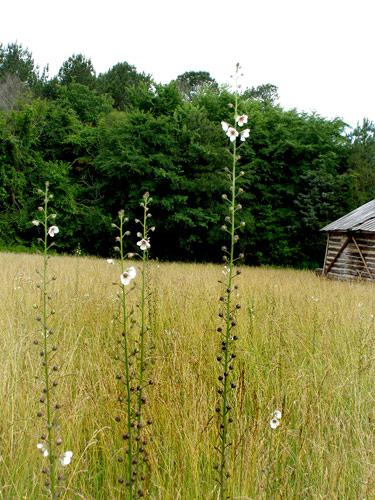Out standing in the fields
By Ken Moore
Even at speeds of 50 or more miles per hour, you may spot some distinctive plants standing out in roadside fields.
During the past week, I’ve been catching glimpses of little white flowers hovering just above the tops of grasses in rural areas outside Carrboro. These white flowers also hover midair-like along some of the unmowed roadside edges closer into town.
I’m particularly aware of them because I have a few quietly showing off in my wild yard just now. I remember being pleased some years ago to discover moth mullein, Verbascum blattaria, in my infrequently mowed yard.
The white, sometimes yellow, flowers of moth mullein begin opening in the evenings and remain fully open until late morning the following day. Though they linger a bit longer on cloudy days, you’re not likely to notice them past late morning.
Each flower opens for only a single day’s length. Moth species are likely pollinators of this night-opening flower. The descriptive species name, blattaria, “moth-like,†is attributed to the Roman naturalist Pliny the elder describing the similarity of the flower’s frilly stamens to antennae on the heads of moths.
Definitely worth “a closer look,†you don’t even need your trusty hand-lens to see the beautiful purple-haired stamens crowned with vivid orange anthers. You can almost imagine some amorous moth approaching one of these flowers in the evening dim, with more than food on its mind.
The plant and its pollinators must be an effective match, because the stems are loaded with round pea-like capsules, each holding numerous maturing seeds for dispersal later in the season.
In contrast to the common woolly mullein, Verbascum thapsus, with its noticeable woolly leaved, cabbage-like, basal rosette, the moth mullein goes unnoticed. The basal leaf cluster of moth mullein hunkers flat on the ground like a pancake-sized, shiny dark-green doily. You may notice the flat-leaf rosettes in late fall and winter when the ground is more exposed to view. If you are lucky enough to spot some in your yard, mow around them to watch them flower next season. You can make your own “Moth Garden†sign for display to curious neighbors.
Both mulleins are naturalized in open, sunny sites, having made their way across the Atlantic long ago with the settlers from Europe.
While you’re out scanning roadsides and fields for moth mulleins, keep an eye out for two other “out standing in the fields†plants: Indian hemp, Apocynun cannabinum, (see carrborocitizen.com/flora/ and search for “Indian hempâ€) and common milkweed, Asclepias syriaca, (search for “common milkweed†and refer to articles “Art of Nature,†7/10/08 and “Observing the common milkweed,†8/16/07). These two plants are true natives.
You will be mesmerized by colorful butterflies and other pollinators visiting Indian hemp stands in some of the fields of Mason Farm Biological Reserve. Common milkweeds with round clusters of purple-pink flowers are evident on the high berm bordering Finley Golf course on Mason Farm Road.
In Carrboro, viewing butterflies on milkweeds is easy along the Frances Shetley Bikeway wild garden behind Carrboro Elementary School.
Plan a walk soon to discover more plants “out standing in the fields.â€




Comments are closed.